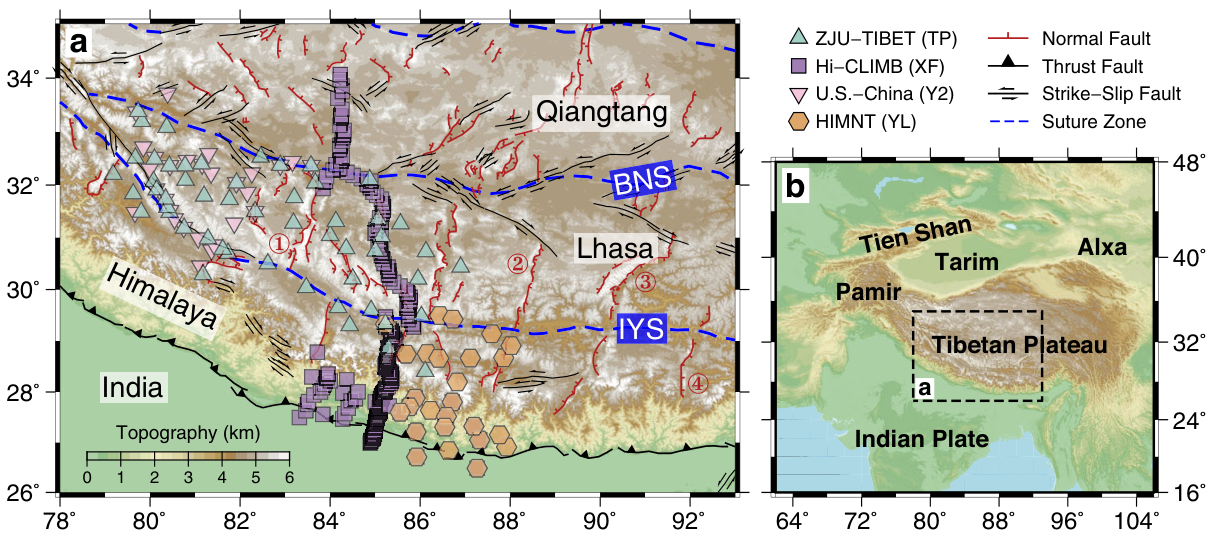Editor: 谢佳 Author: Time: 2023-10-19 Number of visits :136
The Tibetan Plateau, the largest compressional orogenic system on Earth, is currently undergoing orogen-wide crustal extension accommodated by a series of north‒south-trending rifts. However, to date, whether and how these large-scale extensional structures manifested on the surface relate to tectonic processes at depth are still unclear and remain intensely debated, largely due to the lack of direct constraints on the deformation patterns at depth.

Fig. 1 Shaded relief map of the western-central Tibet.
In the study of Zhang et al. (2023), they present new constraints on the nature of seismic anisotropy in the crust and upper mantle of the western-central Tibet through multi-phase shear-wave splitting analyses (including local S-wave, receiver-function Pms phase, teleseismic SKS/SKKS phases). Seismic data are collected from 53 newly deployed ZJU-Tibet stations and previous seismic experiments.
The results show explicit north‒south variations in the patterns of lower-crustal seismic anisotropy that correlate with the changes in tectonic regime within Tibet. Specifically, convergence-parallel anisotropy (CPA, NNE‒SSW) seems to characterize most of the Lhasa terrane and the Tethys Himalaya (i.e., southern Tibetan rift zone), which provides direct observational evidence for the strong subhorizontal shearing between the northwards-underthrusting Indian crust and the overlying Tibetan crust. Orogen-parallel anisotropy (OPA, ESE‒WNW) is dominant in areas to the north and south that feature conjugate strike-slip faulting and thrust faulting, respectively, hinting pure-shear deformation there and likely influenced by fossil anisotropy and strike-slip motions. Furthermore, both seismic anisotropy observations and seismic tomographic images suggest that local-scale mantle upwelling might exist beneath the Lunggar rift in southern Tibet.

Fig. 2 Crustal anisotropy parameters in Tibet.
The above findings suggest that the strong north-directed shearing exerted by the underthrusting Indian plate is key to enabling the present-day extension in southern Tibet. And southern Tibetan rifting is perhaps further enhanced locally by small-scale asthenospheric upwelling through the Indian slab.

Fig. 3 Cartoon illustrating how deep-earth dynamics relate to Tibetan rifting.
This study is led by Prof. Xuewei Bao (the corresponding author), a Hundred-Talent-Plan research professor at School of Earth Sciences, Zhejiang University. The first author of this study is Bingfeng Zhang, a Ph.D. student in Bao’s group. Other authors include Prof. Yixian Xu and Prof. Wencai Yang at Zhejiang University. This research was supported by the Natural Science Foundation of China and the National Key Research and Development Program of China.
For details: Zhang, B., Bao, X., Wu, Y., Xu, Y., & Yang W. (2023). Southern Tibetan rifting since late Miocene enabled by basal shear of the underthrusting Indian lithosphere. Nature Communications, 14, 2565. https://doi.org/10.1038/s41467 023 38296 w
